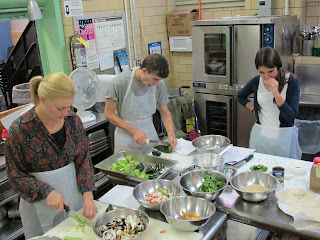


Last Thursday's class, we learned about the process seed saving by collecting seeds from our own lettuce plants. Lettuce was a good plant to start with, in part because we had so much of it, but also because lettuce seeds are self-pollenated, so they are unlikely to cross-pollenate with other seeds. As you can see, lettuce seeds are extremely small, but what they lose in size they make up for in abundance; each flower contains at least a dozen seeds. Here are a few tips about saving lettuce seed:
1) Even if you only need a few seeds, choose and mark more than one plant to collect seeds from. This encourages biodiversity, since different plants may have slightly different seeds; one may be more pest resistant, for example, and another may be better able to tolerate more water. Make sure you mark the plants you will take seed from. This can be done with something as simple as a tag or a label stuck into the soil next to the plant.
2) The seeds of lettuce plants are contained in small flowers that form late in the plant's life, when it is "bolting," or going to seed. These are the stages of a bolting lettuce plant:
a) A stalk will emerge from the top of the plant.
b) This stalk will grow and flower.
c) The flower will self-pollenate and turn into a small puff, not unlike a smaller version of a dandelion.
Many gardeners regard bolting lettuce as a problem, but it is merely a stage in the lettuce's life cycle. As long as you harvest the leaves before the lettuce starts to bolt, those little flowers will actually be to your benefit, as they produce the seeds that you can use to have lettuce forever.
3) Once the seed heads have dried a bit, trim and collect the stalks and harvest the seeds. With lettuce, the easiest method is to just shake them free into a sheet or basket and then collect them into a seed packet. If you'd like to be more thorough, another method is to pull the flowers out of each seed with your fingertips.
4) Next, dry your newly harvested seed for a day or two. There are two possible ways of doing this. If it is sunny, you can just leave the seeds out to sun dry for a day or two, covering them over at night. If the weather is more dark and damp, a good strategy is to hang your stalks in a paper bag inside a warm, dry cupboard.
5) Label your seeds! Although a seemingly obvious step, labeling is extremely important. Write the date, name of variety and germination rate (see below). It's a good idea to do a germination test here, to see how viable your seeds are.
GERMINATION TEST
For this simple test, you will need paper towels, sealable plastic bags, a marker, and a notebook.
1) Moisten a paper towel, so that it is damp but not soggy. A misting spray bottle is a good tool to use.
2) Choose at least ten seeds that you think represent your seed population. For example, we had black, white and gold seeds, so we made sure to include all three in our test. The more seeds you use, the more statistically accurate your results will be.
3) Place your selected seeds on one half of the damp paper towel, and fold it in two over the seeds.
4) Place the towel with the seeds into a partially closed plastic bag. Label the bag. Write the variety of seed, date, and number of seeds on the bag and in your notebook.
5) Keep the bag in a warm, dark place such as a kitchen cupboard. Check the seeds on a daily basis. Note seed progress in your notebook. Make sure to keep the paper towel evenly moist.
6) After several days (the exact time depends on the variety), your seeds should begin to germinate. If a seed looks moldy or rotten, make a note and discard it. If a seed begins to grow, make a note and discard it. Keep notes on how many good and bad seeds you have discarded.
7) After around two weeks, or when all of the seeds have been discarded, tally up what percentage of your seeds were good and bad. If you have a germination rate 50% or higher (meaning that at least 50% of the seeds were good), then go ahead and plant them. Keep in mind that you will only get as many seeds as the germination rate dictates; for example, if you have a 70% germination rate and you plant ten seeds, you will probably only get seven plants. If your germination rate is less than 50%, it's best to buy fresh seed.



